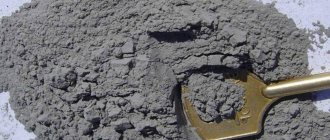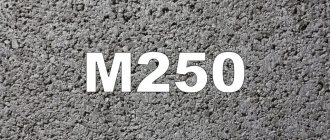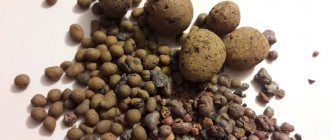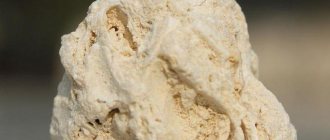When rebuilding and improving his home, the owner often tries to create a special comfort zone there. A private house, cottage, cottage or other individual building is perfectly decorated with fireplaces and original stoves. A separate barbecue area for a fun group wouldn't hurt either. But in order to build a safe structure that can last for many years, you need to select special high-quality materials. This includes refractory cement.
Where is refractory cement used?
Aluminous refractory cement is resistant to high ambient temperatures. This type of binder retains its properties at a temperature comparable to the melting point of steel - 1,750-1,800 °C.
For comparison, structures made on the basis of conventional general construction Portland cement begin to collapse at a temperature of 250 °C, and at a temperature of 500 °C or more, the destruction becomes irreversible.
Purpose of refractory cement:
- Preparation of masonry mortars for the construction of heating stoves and fireplaces.
- Preparation of solutions for coating furnaces of stoves and fireplaces.
- Preparation of solutions for the construction and operation of industrial (tunnel, muffle, laboratory, etc.) furnaces.
- Industrial production of refractories, mortars, dry refractory mixtures, general purpose concrete monoliths.
The technical meaning of the “fire resistance” of cement is as follows: the binder, having a special composition, sets and hardens to form so-called “ceramic bonds.” In this case, general construction cement sets and hardens to form “hydraulic bonds.”
DETERMINATION OF LIQUID GLASS MODULE BY ACCELERATED METHOD
The average sample for analysis is taken from the upper settled layer of liquid glass without stirring, after first removing the surface film, then proceed to determine the content of sodium oxide in it. To do this, liquid glass is diluted with water to a density of 1.38 g/cm3. Then a sample of liquid glass weighing about 1 g is washed off with hot distilled water into a beaker with a volume of 250-300 ml, mixed thoroughly, covered with a watch glass and boiled for 10 minutes.
After cooling, add 3-4 drops of 0.2% methyl orange solution to the solution and titrate with 0.1 normal HCl solution until the color of the liquid changes from yellow to pale pink.
The modulus of liquid glass is determined by the formula
Msg = 162dι- 2.5,
where d is a sample of liquid glass, ι is the volume of 0.1 HCl solution consumed during titration, ml; 162 and 2.5 are empirical coefficients.
Characteristics of refractory cement
Aluminous cement is produced by the method of joint sintering and very fine grinding of several components. In particular, the composition of refractory cement includes the following components:
- Refractory alumina not less than 60%. Main component.
- Calcium oxide up to 35-40%.
- Additives up to 3-5% no more.
Externally and tactilely, commercial heat-resistant cement is a finely dispersed (when sifting laboratory samples through a test sieve with a cell size of 0.08x0.08 mm, “no more than 10%” is allowed) powder of dark brown, gray, light gray or whitish color, depending on alumina content.
Characteristics of a concrete mixture based on refractory cement:
- Compressive strength value: 250-600 kgf/cm2 24-72 hours after mixing the composition.
- Resistance to harmful factors (acid, alkali, mineral hydrocarbonate water, sulfates, etc.): high.
- Structure of the hardened material: low-porous, moisture-proof.
- High level of heat release generated during cement hydration: up to 70% in the first 24 hours after mixing from 100%.
- Permissible operating temperature of products and structures: 1,200-1,800 °C depending on the type and amount of additives (fireclay powder, chromium powder, magnesite powder).
Features of preparing working solutions
Regardless of the chosen composition of the refractory mixture, the master will need water in any case.
It should not contain large amounts of hardness salts - calcium and magnesium bicarbonates. Usually, the population knows the characteristics of local water, the location of sources with water of low hardness. If necessary, you can slightly soften the water using special methods, but it is advisable to do this only as a last resort, since the pleasure will be quite expensive.
For do-it-yourself masonry of all parts of the furnace, white sand with a quartz composition is ideal. Yellowish sand grains can be used for laying any parts of the stove structure, except for the combustion chamber.
There are long-standing historical methods for determining the amount of sand to add to clay. The ancestors lived a leisurely, measured life, so the mixtures were tested for more than 3 weeks. Now people do the test faster - they prepare several versions of cakes or balls, wait for them to dry completely, then drop them onto a wooden surface from a height of one meter. The composition that did not split is worthy of attention. If there are several such resistant samples, the height for testing can be increased, ultimately choosing the most durable option.
The final control check can be carried out as follows: smear the wide part of the brick (bed) with the prepared mixture with a layer of mortar of at least 3 mm, lay the second brick on top, press it well by tapping it with a wooden handle, wait 10 minutes and lift it. If the bottom brick is held and does not fall, the compound is suitable.
Marking of heat-resistant cement
Regulatory document GOST 969-91. “Aluminous and high-alumina cements”, depending on the content of aluminum oxide (Al₂O₃) in the binder, differentiates heat-resistant cement into the following types:
- Aluminous material GC.
- High-alumina material VGC I, VGC II, VGC III.
Depending on the achieved concrete strength within 72 hours, GOST 969-91 differentiates cement into the following grades:
- GC 40, GC 50, GC60.
- VGC I-35.
- VGC II-25, VGC-35.
- VGC III-25.
- VGTs 70-VGTs 75
- VGKTs-70-1.
Arabic numerals, 40,50,60,25 and 35, inform the consumer that a concrete material based on one or another type of refractory cement, 72 hours after mixing, under standard curing conditions (air temperature 20-25 °C, 75- 80% relative humidity) will have a compressive strength of 40 MPa, 50 MPa, 60 MPa, etc.
An example of the designation of heat-resistant cement: Fire-resistant cement Hz 40 GOST 969-91. Fire-resistant aluminous cement. The achieved compressive strength 72 hours after mixing the concrete mixture is 40 MPa or 400 kgf/cm2. Empirical fire resistance 780-1,000°C. The fire resistance of this type of binder is not regulated by GOST 969-91.
How to plaster a brick oven
So, having dealt with the question of what mortar is used for laying a brick oven, we move on to considering another position. Namely, what solution to cover the stove with so that it does not crack.
Firstly, you need to give time for the brick structure to shrink. Secondly, before starting plastering, the stove must be heated. The goal is to expand it in volume. Thirdly, a mesh is laid on the surface, which will strengthen the plaster layer. After which you can proceed to the main process.
The better to plaster. There are many options - these include ready-made mixtures and those prepared independently. The simplest is the clay mortar used for laying. Popular experience shows that it is necessary to add salt and wood ash to it. Two ingredients will not only increase the strength of the mixture, but also increase its heat resistance.
Plaster of a brick oven with a mesh attached to it Source avatars.mds.yandex.net
Before you prepare a solution from ash to putty the stove, you need to prepare all the ingredients. Here the ratio is:
- clay should be twice as much as sand;
- salt is added at the rate of 30 g per 1 liter of clay-sand mixture;
- ash at the rate of 50-60 g per 1 liter.
Purpose of certain types of heat-resistant cement
- Aluminous cement GC40-GC60. Production of dry refractory mixtures, road construction, concreting at subzero temperatures, coating of fireboxes for household stoves and fireplaces.
- High-alumina cement VGTs 70-VGTs 75, VGTsI-VGTsIII. Construction of structures operating at very high ambient temperatures. Production of quick-hardening concrete mortars for various purposes.
- High-alumina cement VGKTs-70-1. Production of refractories, lining of industrial furnaces, construction of furnace substrates.
Directions for use
Refractory types of cement can be used for all construction work. Given economic considerations, it is most often used in situations where the structure is constantly exposed to high heat. Demand for refractory cement products arises in industry and private property.
The main areas of application of refractory high-alumina cement are as follows:
- lining of heated space in heating complexes and units;
- production of heat-resistant structures from reinforced concrete;
- production of fire-resistant panels, bricks, blocks, mortars;
- preparation of adhesive compositions for oil and chemical installations;
- production of furnaces for melting glass products;
- production of structures in the thermal power industry;
- construction of chimneys, home stoves, fireplaces.
Refractory types of cement are in demand in the mining and metallurgical industries, as well as in the construction of tunnels and substrates for powerful thermal installations in any field.
Prices for refractory cement
In accordance with the special purpose and special manufacturing technology, the cost of refractory cements is quite high. In addition, large quantities of this type of material are usually manufactured to special order. At this point in time, the retail price of refractory cement is:
- Cement GC-40, GC-50, GC-60: 1,600 rubles per bag weighing 50 kg. Manufacturer: Pashiysky Metallurgical-Cement Plant OJSC, Russian Federation.
- Cement VGTs 70-VGTs 75, VGTsI-VGTsIII: 1480-1550 rubles per bag weighing 20 kg. (NIZHNETAGIL PLANT OF ALUMINA CEMENTS) Russian Federation.
- Cement VGKTs-70-1: 1,580-1,680 rubles per bag weighing 20 kg. , Russian Federation.
Video description
The video shows how to prepare a clay mortar for laying a stove:
What is gas density - this is a characteristic of a solution, which shows that dense gases from fuel combustion cannot pass through the thickness of the applied mixture by diffusion. It should be noted that gas density is not hygroscopicity. The thing is that water vapor is more mobile, so it easily passes through the material. Hence the concept of “breathable” structures. For example, a cement-sand mortar does not allow vapor to pass through when it dries. But carbon monoxide still passes through it. Therefore, it is very important that the solutions used in the construction of furnaces must be selected in accordance with both hygroscopicity and gas density.
How to make refractory cement with your own hands?
Very high prices and limited availability of purchasing special refractory cement create certain difficulties for ordinary private developers who want to have heating stoves and heating fireplaces at their disposal.
There is a lot of information on the Internet about how to make refractory cement for stoves and fireplaces using various heat-resistant additives: expanded clay, asbestos (banned due to its carcinogenicity), blast furnace slag, broken fireclay bricks, fly ash and even chromite ore which is unknown where can buy.
Based on practical experience in the successful operation of a heating stove in a private home, a conclusion can be drawn. For the construction and operation of a firebox and other furnace structures located under the roof of a building, you can and should use a solution of clay and sand mixed in proportions 1:1, plus a sealer to the consistency of “homemade sour cream.”
For the construction of a chimney and part of a chimney located under the roof of a building, you can use a solution prepared according to the proportion indicated above. The part of the chimney located above the roof of the building is built on the basis of a masonry mortar prepared according to a recipe: ordinary Portland cement of any brand, mixed with sand in a ratio of 1:2.
CHECKING THE QUALITY OF THE HARDENER
To check the quality of the hardener (except for sodium silicofluoride), a sample of about 5 kg is taken from each batch from several places, but not less than three, and reduced to 0.5-1 kg using the quartering method. Next, the material is dried to constant weight at a temperature of 100-110 ° C and the grinding fineness and chemical composition are determined. To control the grinding fineness, take a sample of the material weighing 100 g and sift it through sieve No. 008. The chemical composition of all hardeners (except sodium silicofluoride) is determined according to GOST 2642.0-86.
To check the quality of the hardener - sodium silicofluoride, an average sample is taken, dried to a constant weight at a temperature of 100-110 ° C and crushed in a mortar.
A sample of the material weighing about 1 g is dissolved in 100 ml of hot water, free of carbon dioxide, and titrated with a 0.5 normal NaOH solution containing two to three drops of phenolphthalein until a faint pink color appears. The solution is then heated to boiling and titrated again until the color no longer discolors. A slight pink color upon boiling indicates the end of the titration. The percentage of sodium silicofluoride in a technical product is calculated using the approximate formula
m = 0.0235/K V 100,
where 0.0235 is the amount of Na2SiF6 corresponding to 1 ml of 0.5 normal NaOH solution; V
— volume of 0.5 N NaOH solution used for titration, ml;
K
- weighed portion of technical sodium silicofluoride, g.
To determine the activity of hardeners, mix 200 g of finely ground chamotte and 100 g of a hardener (nepheline sludge, self-disintegrating slag, phosphorus slag) or 30 g of a hardener (sodium silicofluoride), mix with liquid glass until a dough of normal thickness is obtained, a cake is made from the resulting mixture, which is immediately wrapped in plastic wrap. After keeping the cake in the film at a temperature not lower than 20 ° C for 24 hours, it is removed and broken.
A high-quality hardener ensures good hardening and strength of the cake over its entire cross-section.
Scope of application
The scope of use of the material is not limited to the manufacture of thermally resistant structures: combustion chambers, home or industrial furnaces, collectors and foundations. Due to the inclusion of specific ingredients in the composition, the material is widely used in the production of building materials, the chemical industry, and the energy sector.
Heat-resistant concrete is also used for the construction of floating structures, floors, bridges - in structures that require high strength of the material with low weight. The relatively small mass of concrete is due to the addition of porous fillers.
Scope of application
The production of refractory concrete began during the emergence of blast furnaces. They were used for lining air heaters and the front walls of open hearths.
Their production was carried out mainly at metallurgical enterprises, but over time it became a separate industry with a wide scope of application.
Application of refractory concrete in metallurgy
The advantages of the material are:
- availability of constituent components;
- high thermal insulation properties;
- resistance to sudden temperature changes;
- enhancing strength characteristics during operation;
- no need for firing after pouring.
Products made from refractory concrete are used in all areas where high temperature loads are possible:
- when creating load-bearing structures for industrial furnaces at metallurgical plants;
- in organic synthesis processes during hydrocarbon processing;
- brick kilns;
- in the construction of fireplaces and hearths in private cottages;
- for internal lining of boilers;
- thermal insulation of objects under construction;
- construction of floating structures that require low weight but high strength.
This is interesting: Voluntary fire department - tasks and creation procedure











